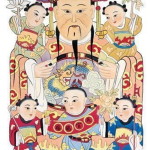The Tibetan ethnic group is an age-old one, where there was an ancient regime called the Tubo Kingdom. In 641 AD, after its king Songtsen Gampo united the warring tribes on the Tibetan plateau, he sent messengers to the capital of the Tang Dynasty, Chang’an (Xi’an), to seek a bride. The Tang Emperor agreed and Princess Wencheng was sent to Tibet. From this beginning, the Tibetan and Han nationalities have gone on to make great progress in political, economic and cultural exchanges.
The Tibetan people are mainly distributed in the Tibetan Autonomous Region, Qinghai, Gansu, Sichuan, and Yunnan provinces, and most of them live on plateaus at high altitude. The Qinghai-Tibet Plateau is over 4,000 m above sea level on average and the world’s highest peak, Mount Everest, towers above many massive peaks there. The area where the Tibetans live has vast grasslands and is crossed by many rivers. Yaks, with a fat body and long hair, can resist cold and are capable of carrying a heavy load long distances, so they have long been an important transportation “tool” on the plateau.
The clothes of the Tibetan people have unique national features. Usually they wear a short jacket with long sleeves made of silk or cotton with a loose gown over it, and a pair of high leather boots. For convenience when working, they often bare the right shoulder or even both arms, tying the two sleeves around the waist. Tibetan men and women all wear plaits; men coil the plait on top of the head while women wear two plaits, or sometimes many, over the shoulders, with beautiful ornaments woven into the ends. Women also like to tie an apron with beautiful patterns around their waist. The Tibetan people love to drink butter tea, and eat tsampa made of highland barley flour, beef and mutton.
The Tibetan people have a unique ceremony – presenting a hada. The hada is a piece of specially made white long cloth. When visiting or entertaining distinguished guests, Tibetan people present it draped over both their hands to express their respect.
The Tibetan ethnic group has a long cultural tradition. A unified written Tibetan language was established in the early years of the Tubo kingdom in the 7th century; traditional Tibetan medicine, Tibetan drugs, Tibetan pictures, Tibetan operas, Tibetan songs and dances, and Tibetan literature all have their unique style. The magnificent Potala Palace in Lhasa is a masterpiece in architectural history listed in the World Cultural Heritage List.
In religion, Tibetans follow a form of Buddhism known as Lamaism or Tibetan Buddhism, and the grandest festival is New Year’s Day in the Tibetan calendar, when people greet each other and go to temples to worship and pray for good fortune. On April 15th, religious ceremonies are held to commemorate the day when Sakyamuni became Buddha and Princess Wencheng reportedly reached Tibet.









Leave a Reply